 Image search results - "toka" Image search results - "toka" |

Ishibe-juku was the 51st stage/post or shukuba lodging town on the Tokaido Road where even Emperor Meiji once stayed (with an entourage of over 3,000). View from JR Ishibe Station. Ishibe in Konan city is rural, yet it has a few major industries operating.
|
|

Kusatsu-juku was the fifty-second station on the Tokaido Road (following Ishibe-juku) and the sixty-eighth station (following Moriyama-juku) on the Nakasendo Road. During the Edo Period, Kusatsu was an important post town at the crossroads of both roads.The roof is shaped like a Honjin lodge, with a gate. 草津駅
|
|
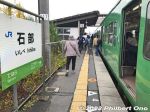
JR Ishibe Station platform.
|
|
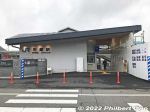
New JR Ishibe Station, Kusatsu Line. New station under construction in late 2022.
|
|

JR Ishibe Station before renovations.
|
|

JR Kusatsu Station
|
|

JR Ishibe Station
|
|

Kusatsu town map. Kusatsu basically developed along the old Nakasendo and Tokaido Roads as they intersected before going on to Kyoto, Shiga's neighboring prefecture.
|
|

In front of JR Ishibe Station. There are many bicycle garages for out-of-town students who commute from the station to their high school in Ishibe.
|
|

Kusatsu River
|
|

Gate in front of Ishibe Station
|
|

Oiwake Guidepost road marker at the intersection of the Tokaido and Nakasendo Roads. The left side says "Left for Nakasendo Road" and the right side says "Right for Tokaido Road."
|
|
|
|

Road marker at the intersection of the Tokaido and Nakasendo RoadsThis tunnel goes under the Kusatsu River.
|
|
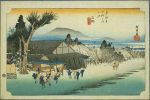
Hiroshige's woodblock print of Ishibe-juku (51st post town on the Tokaido) from his "Fifty-Three Stations of the Tokaido Road" series. A tea house is depicted.
|
|

Dengaku Chaya tea house reconstructed in 2003 based on Hiroshige's ukiyoe print of Ishibe. A rest place for tourists. Walkable from Ishibe Station. 田楽茶屋The original tea house as seen in Hiroshige's print was located some distance away (nearer to Ritto) from the location of this reconstructed tea house.
|
|
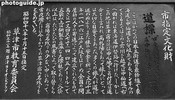
Road marker plaque
|
|

Inside reconstructed tea house
|
|

Kusatsu historyBeing a stage town along the Tokaido Road connecting Edo (Tokyo) and Kyoto, Kusatsu had over 70 inns for travelers. The best inn was the Honjin, reserved for daimyo warlords, Imperial family members, etc.
|
|

Site of Kojima Honjin and Emperor Meiji marker. The Kojima Honjin was Ishibe-juku's best accommodation suited for feudal lords and emperors.
|
|

Kusatsu-juku Honjin on the Tokaido Road. MAP
|
|

Ishibe was usually the first overnight stop for travelers going from Kyoto to Edo (Tokyo). The Honjin is no longer in existence, and only a normal house sits on the site.
|
|

Kusatsu-juku Honjin. the Honjin was the town's most luxurious accommodation catering to society's elite like daimyo warlords, Imperial family members including the emperor, and other dignitaries. National Historic SiteAt stage towns along the major roads like the Nakasendo and Tokaido, the Honjin was the town's most luxurious accommodation catering to society's elite like daimyo warlords, Imperial family members including the emperor, and other dignitaries. It operated during 1635 to 1870. The Honjin is now a museum.
This Honjin in Kusatsu is a very impressive example of traditional architecture. It is designated as a National Historical Place. It underwent a complete renovation and reconstruction during 1989 to 1995. (In case you wonder why such an old building looks so new.) Admission 200 yen. 10-min. walk from Kusatsu Station.
|
|

Woodblock print of Ishibe-juku
|
|

Kusatsu-juku Honjin entrance. This Honjin in Kusatsu is a very impressive example of traditional architecture. It is designated as a National Historical Place. It underwent a complete renovation and reconstruction during 1989 to 1995. Admission 200 yen.
|
|

Entrance to Ameyama Cultural Sports Park, a low hill with various sports and cultural facilities and hiking trails.
|
|

Genkan Hiroma entrance hall straight ahead. It was the entrance for daimyo feudal lords. 玄関広間
|
|
|
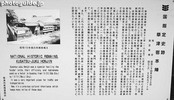
About the Kusatsu-juku Honjin
|
|

Entrance to Shukuba no Sato, outdoor museum of stage town buildings 宿場の里 MAP
|
|

Sekifuda name plates in Genkan Hiroma entrance hall. This is what you see when you enter the Honjin through the Genkan Hiroma entrance hall. The name plate for the warlord staying at the lodge was displayed. 玄関広間This is what you see when you enter the Honjin through the Genkan Hiroma entrance hall. The name plate for the warlord staying at the lodge was displayed here.
|
|
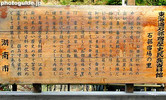
About Shukuba no Sato. Interesting outdoor museum of Edo-Period buildings accurately reconstructed as was found in Ishibe-juku. You can find a farmer's house, merchant's house, inn, tea house, and warehouse. The inside is also quite authentic.
|
|

Kusatsu-juku Honjin corridor. Pass by numerous Japanese-style rooms. 畳廊下畳廊下
|
|

Gate 関所
|
|

Kusatsu-juku Honjin guest book. See the names of Kira and Lord Asano both of whom once lodged at this Honjin (at different times). These two men later became adversaries which led to the legendary chushingura or vendetta of the 47 masterless samurai. 大�You can see the names of Kira and Lord Asano both of whom once lodged at this Honjin (at different times). These two men later became adversaries which led to the legendary chushingura or vendetta of the 47 masterless samurai.
大福帳
|
|

Traditional farmer's house 農家
|
|

Jodan no Ma: Kusatsu-juku Honjin's best room in the house. Reserved for daimyo warlords, emperors, etc. 上段の間
|
|

Traditional farmer's house
|
|

Jodan no Ma - Kusatsu-juku Honjin's best room in the house. Reserved for daimyo warlords, emperors, etc. 上段の間
|
|

Traditional farmer's house
|
|

Jodan no Ma - Kusatsu-juku Honjin. The Gyokuza raised tatami mats was where the lord or Emperor slept or sat. 上段の間Reserved for daimyo warlords, emperors, etc.
|
|

Traditional farmer's house
|
|

Jodan no Ma - Kusatsu-juku Honjin's best room in the houseReserved for daimyo warlords, emperors, etc. The room had an elevated tatami mat for the person to sit and sleep on.
上段の間
|
|

Old farming implements (for irrigation)
|
|

Mukae Jodan no Ma 向上段の間向上段の間
|
|
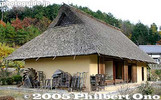
Farmer's house
|
|

Mukae Jodan no Ma. Painting on the fusuma sliding doors by Matsumura Keibun. 向上段の間
|
|

Merchant's house 商家
|
|

Urinal (made of lacquered wood) for warlords. The room has two tatami mats. Right below the urinal is a bamboo mat. Above is a small shoji paper window to provide light.
|
|

Merchant's house
|
|

Toilet (made of lacquered wood) for warlords. This is a separate room adjacent to the urinal. It also has two tatami mats. The walls are plain and not decorated. The toilet had a box which was likely replaced each time it was used. 上段雪隠This is a separate room adjacent to the urinal. It also has two tatami mats. The walls are plain and not decorated. The toilet had a box which was likely replaced each time it was used.
Jodan settin
上段雪隠
|
|

Inn (hatago) 旅籠
|
|

Marker for Emperor Meiji's visit and outdoor garden
|
|

Guest name plates in the inn
|
|

Outdoor garden
|
|

Ishiyama Station on the Keihan Line and JR Tokaido Line.
|
|

Inn
|
|
|

Inn kitchen
|
|

Yudono bath room for warlords. The hot water was heated nearby and carried to this room. 湯殿
|
|
|
|

Bath for feudal lordsLooks kind of small to me.
湯殿
|
|

Rice warehouse
|
|

Kitchen (Daidokoro doma). Dirt-floored room with wood-heated stoves. High ceiling with no chimney, but the ceiling has a covered opening. 台所土間
|
|

Rice warehouse
|
|

Honjin owner Tanaka's house
|
|

Tea house
|
|

Honjin owner Tanaka's house
|
|

Tea house
|
|

Honjin owner's house
|
|
|

Ceiling
|
|

Old fire truck
|
|

Kusatsu-juku Kaido Koryu-kan is a history museum with various exhibits showing Kusatsu's post town history. Admission 200 yen. You can buy a set ticket good for both the Honjin and this history museum. 草津街道交流館
|
|
|

Kusatsu-juku Kaido Koryu-kan. Terminals are provided to find information about Kusatsu. 草津街道交流館 MAP
|
|

Tokaido History Museum is adjacent to Shukuba no Sato. It explains the 53 stage towns of the Tokaido Road between Edo and Kyoto. 東海道歴史資料館
|
|

Kusatsu-juku Kaido Koryu-kan 草津街道交流館
|
|

Tokaido History Museum includes an accurate model of Ishibe-juku's palatial Kojima Honjin.
|
|

Kusatsu-juku Kaido Koryu-kan. Sample food from the old days, dinner on left and breakfast on right. 草津街道交流館
|
|

Ishibe Town logo
|
|

Photo op room at Kusatsu-juku Kaido Koryu-kan. You can dress up as a traveler on the Tokaido/Nakasendo Road and take a picture of yourself. You can even sit in the palanquin. A tripod is provided too. 草津街道交流館
|
|

Church house
|
|

Palanquin at Kusatsu-juku Kaido Koryu-kan 草津街道交流館For photos.
|
|

Church house
|
|

Ukiyoe prints of Kusatsu-juku at Kusatsu-juku Kaido Koryu-kan 草津街道交流館
|
|

Ishibe High School. Rare to see a Japanese high school whose name is shown in English.
|
|

Kusatsu-juku Kaido Koryu-kan草津街道交流館
|
|
|
|

Model of the town at the Kusatsu-juku Kaido Koryu-kan 草津街道交流館
|
|

Waki Honjin souvenir shop and restaurant脇本陣
|
|
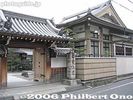
Temple with road marker
|
|

Closeup of road marker indicating the Tokaido Road to the right and Nakasendo to the left.
|
|

Way to Kyoto Ebisu Shrine during Toka Ebisu as seen from Shijo.
|
|

Food stalls crowd the path to shrine.
|
|
|
|
|

Originally established in 1202, Kyoto Ebisu Shrine is one of Japan's three major Ebisu shrines, besides Imamiya Ebisu Shrine in Osaka and Nishinomiya Shrine.
|
|

Toka Ebisu decorations.
|
|

Torii and entrance to Kyoto Ebisu Shrine.
|
|

Shrine ahead
|
|
|

People line up and inch their way to the shrine to offer prayers.
|
|
|

Kyoto Ebisu Shrine on its busiest day of the year.
|
|

As people ring the bell and pray for prosperity amid the current recession, the shrine rakes in the money on its most important day of the year, Jan. 10.
|
|

Praying at Kyoto Ebisu Shrine.
|
|
|

Big tuna fish
|
|

Big tuna fish as an offering.
|
|

Shrine offerings
|
|

Last year's Toka Ebisu decorations are brought to the shrine and trashed.
|
|

Last year's Toka Ebisu decorations are brought to the shrine and trashed.
|
|

People line up for bamboo branches.
|
|
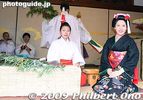
An actress dressed almost like a geisha is on hand to give bamboo branches paid for by worshippers. Notice the shrine maiden dancing in the back to bless the branches.
|
|
|

Bamboo branch given by an actress. I wondered why the shrine does not hire a real geisha/geiko or maiko to hand out the bamboo branches. (Geisha district Miyagawa-cho is right around the corner.)
|
|

Shrine maidens happily sell and attach lucky decorations on the branches.
|
|

Shrine maidens happily sell and attach lucky decorations on the branches.
|
|

Shrine maidens happily sell and attach lucky decorations on the branches.
|
|
|
|
|

Shrine maiden selling Ebisu souvenirs.
|
|
|

Ebisu amulets.
|
|

Shrine ema tablets.
|
|

Omikuji fortune paper strips.
|
|

On the way out, knock on this wall for prosperity.
|
|

On the way out, knock on this wall for prosperity.
|
|

Shichiri-no-watashi at Kuwana, Mie. Adjacent to Kyuka Park is the Kuwana-juku post town on the Tokaido Road. The building on the right is on the site of the Waki-Honjin.
|
|

The 28-km ocean crossing from Miya-juku to Kuwana took about 4 hours. It was often perilous with rough waters.
|
|

Next to Shichiri-no-watashi was Kuwana-juku's Waki-Honjin.
|
|

Building on the site of Kuwana-juku's Waki-Honjin. It is a ryokan inn.
|
|

Next to the Waki-Honjin was the Honjin whose site is now occupied by this building.
|
|

Site of Kuwana-juku's Honjin.
|
|

Sign explaining Kuwana's Honjin and Waki-Honjin.
|
|

Tokaido Road in Kuwana-juku.
|
|

Kyuka Park moat near Shichiri-no-watashi.
|
|

Minakuchi-juku was the fiftieth of the fifty-three stations of the Tokaido Road. The most prominent remnant is Minakuchi Castle. Short walk from Minakuchi Jonan Station and Minakuchi Ishibashi Station on the Omi Railway Line.Omi Railway Line at Minakuchi Ishibashi Station platform, the closest station to Minakuchi-juku.
|
|

Inside Minakuchi Ishibashi Station, somewhat rundown.
|
|

Minakuchi Ishibashi Station. When you exit, go right until you see the train tracks on the right. Cross the tracks and you will be heading toward Minakuchi-juku.
|
|

After crossing the train tracks, you see this forked intersection. The road forks into three roads. The one in the middle is the old Tokaido Road. There is also a monument.
|
|

The monument takes the shape of a hikiyama float. It contains a clock inside. MAP
|
|
|

This plaque shows a woodblock print by Hiroshige depicting Minakuchi-juku. (A clearer image of this print is shown below.)
|
|
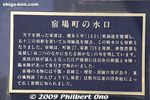
In 1601, Minakuchi-juku was designated as the 50th stage or post town on the Tokaido Road. It had 718 households. By the late Edo Period, Minakuchi had over 40 inns as well as a Honjin. Today, Minakuchi is one of the main populated areas of Koka.
|
|

Old Tokaido Road.
|
|

Near the forked intersection is Daitokuji Temple. Originally a Zen temple, it now belongs to the Jodo-shu sect. When Tokugawa Ieyasu passed through and visited the temple, he renamed it Daitokuji. 大徳寺
|
|

Daitokuji Temple gate
|
|

Daitokuji Temple's founding priest was an uncle of Honda Tadakatsu (Heihachiro), one of Tokugawa Ieyasu's important generals. Due to this connection, Ieyasu lodged in Minakuchi on his way to Kyoto and visited Daitokuji.
|
|

Daitokuji Temple Hondo Hall. Ieyasu donated land to the temple as well as a tree. He even created the temple's crest and renamed the temple to Daitokuji.
|
|

Daitokuji Temple Hondo Hall.
|
|

Jizo statues next to the Daitokuji Temple Hondo Hall.
|
|

Rock with Buddha's footprints.
|
|

Monument for the rock which Ieyasu sat on.
|
|

This is the rock which Tokugawa Ieyasu sat on when he visited the temple in May 1600. He sat on it while talking to the temple priest. Anyone can now sit on it. Called Tokugawa Ieyasu koshi-kake ishi. It was moved here in 1900. 腰掛石
|
|

A famous tree at Daitokuji.
|
|
|

Walk a little further east and north to visit the former Minakuchi Public Library designed by William Vories and built in 1928.
|
|

Former Minakuchi Public Library is next to Minakuchi Elementary School. 旧水口図書館
|
|
|
|

Entrance to the former Minakuchi Public Library has Romanesque columns.
|
|

Staircase inside former Minakuchi Public Library.
|
|
|

Inside former Minakuchi Public Library. Now it is sometimes used as an art gallery.
|
|

About Vories.
|
|

Walk further along and there is this path to Daikoji temple.
|
|

Daikoji temple was founded in 684 by priest Gyoki (行基) who installed a wooden Thousand-Arm Kannon statue (now missing). 大岡寺
|
|

Daikoji temple. The current building was reconstructed in 1715. It is one of the 33 temples on the Saigoku Pilgrimage in western Japan. 大岡寺
|
|

According to NHK in Oct. 2013, the whereabouts of two Important Cultural Property Buddhist statues from Daikoji temple in Koka are unknown. Reported to be have been stolen & sold.
|
|

Daikoji temple's bell tower. 「木造千手観音立像」と「木造阿弥陀如来立像」は寺の関係者が勝手に持ち出したあと第三者に売り渡された。
|
|

Basho Matsuo Haiku monument at Daikoji temple.
|
|

Monument for Iwaya Ichiroku, a noted calligrapher hailing from Minakuchi.
|
|

Pond for the souls of fish offered to the temple.
|
|

Old Tokaido Road
|
|

Another intersection.
|
|
|
|

Another clock monument
|
|

This is the site of Minakuchi-juku's Toiyaba which was like a travel logistics office and lodging reservations agency. Staffed by one or more people, it handled horses, messengers, luggage, helpers, etc. 問屋場
|
|
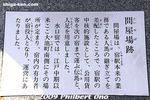
About Minakuchi-juku's Toiyaba.
|
|

A more traditional-looking part of the former Tokaido Road.
|
|

Here and there along the way, you'll see storehouses for the hikiyama floats. During the Minakuchi Hikiyama Matsuri festival on April 19-20, they are taken out to be decorated before being paraded to Minakuchi Shrine.
|
|

Nearing the end of Minakuchi-juku.
|
|

At the east end of Minakuchi-juku is the spot where the Kosatsu bulletin board stood.
|
|

This is a reconstruction of the Kosatsu bulletin board which displayed official notices from the shogunate. These bulletin boards were placed where many people passed by so they can stop and read the bulletins. 高札場
|
|

Sample bulletins on the Kosatsu bulletin board. That's a lotta fine print...
|
|

Not far from the Kosatsu bulletin board was Minakuchi-juku's Honjin. Nothing remains of the Honjin. This is the entrance to where it was located. 本陣跡
|
|

The Honjin was the town's most exclusive lodge reserved for daimyo lords, government officials, and even Emperor Meiji who once stayed here as this monument indicates.
|
|

Monument indicating that Emperor Meiji who stayed here in 1869. He was the last guest since the Honjin was then closed and dismantled. The Waki-Honjin was also nearby, but no signs.
|
|
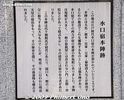
About Minakuchi's Honjin.
|
|

Further east is the Higashi-Mitsuke Gate.
|
|

Reconstructed Higashi-Mitsuke Gate. 東見附跡
|
|

The Higashi-Mitsuke Gate was like the town's checkpoint with security guards posted watching people entering the town. There was another checkpoint on the west end of the town.
|
|

About Higashi-Mitsuke Gate. After reaching this gate, you might as well backtrack back to the train station.
|
|

This is the hill where the Minakuchi-Okayama Castle was originally built in 1585 by Nakamura Kazuuji 中村一氏, a vassal of Toyotomi Hideyoshi. It fell into ruin after the Battle of Sekigahara where the castle lord lost.
|
|

Old Tokaido Road in Minakuchi
|
|

Minakuchi Hikiyama float storehouse
|
|

After reaching Higashi-Mitsuke Gate, backtrack back to the train station and cross the train tracks to the other side of the Tokaido Road. You will be heading toward Minakuchi Castle. Minakuchi manhole. Shiga Pref.
|
|

A short walk from Minakuchi Ishibashi Station is Minakuchi Chubu Community Center.
|
|

This Community Center also houses a hikiyama float.
|
|
|
|

A detour on the old Tokaido road.
|
|

A detour on the old Tokaido road, created due to the castle grounds.
|
|

Minakuchi Christian Church designed by Vories. 水口教会会堂
|
|

Minakuchi Christian Church designed by Vories and built in Nov. 1930.
|
|
|

Way to Shintokuji temple. 真徳寺
|
|

This front gate at Shintokuji temple was moved from a lord's residence within Minakuchi Castle. 真徳寺
|
|

Shintokuji temple. 真徳寺
|
|

Minakuchi Stone at this corner is nicknamed Chikara Ishi (Stone of Strength) and was made famous by a woodblock print during the Edo Period. 力石
|
|

About Minakuchi Stone
|
|

Local shrine 五十鈴神社
|
|
|
|

A tree shows where the Ichirizuka marker was. It served as a milestone and distance marker for travelers.
|
|
|

Saw this along the way to Minakuchi Castle.
|
|

Stone monument commemorating the formation of Koka upon the merger of neighboring towns. (Minakuchi, Koka, Shigaraki, Konan, Tsuchiyama)
|
|

Minakuchi Castle was originally built in 1634 as a rest place for shogun Tokugawa Iemitsu during his travels to and from Kyoto. But the shogun stayed at the castle only once.
|
|

The castle later became the residence of the Minakuchi clan in 1682 headed by Lord Kato Akitomo. MAP
|
|
|
|
|
|
|

Bridge to Minakuchi Castle.
|
|

Minakuchi Castle Museum is open 10 am to 4 pm, closed on Thursday and Fri. 水口城資料館
|
|
|
|

Inside Minakuchi Castle Museum 水口城資料館
|
|
|
|
|
|

The only part of the castle that looks like a castle is the small, rectangular area (connected by a short bridge) seen on the left side of the map. The large square area on the right is now an athletic/sports ground as you can see in the next picture.
|
|

The Honmaru (main keep) is now the sports ground for Minakuchi High School.
|
|

Now we are approaching Minakuchi Shrine.
|
|

Minakuchi Shrine torii
|
|

Minakuchi Shrine torii 水口神社
|
|

Minakuchi Shrine decorated for the Minakuchi Hikiyama Matsuri festival on April 19.
|
|

Minakuchi Shrine
|
|

Minakuchi Shrine
|
|

Minakuchi Shrine
|
|

Near Minakuchi Shrine are these storehouses for hikiyama floats.
|
|

Minakuchi Public Library and folk history museum. 水口歴史民俗資料館
|
|

An early map of Minakuchi-juku.
|
|

1: Honjin, 2: Waki-Honjin, 3: Kosatsu bulletib board. Daikoji temple can also be seen on the upper left.
|
|

The museum also exhibits an actual Minakuchi Hikiyama float used in the annual Minakuchi Hikiyama Matsuri festival during April 19-20. One of the 16 floats is displayed here every year.
|
|

Inside Minakuchi Folk History Museum
|
|
|
|

Pilgrimage clothing
|
|

Pieces from Minakuchi Okayama Castle ruins.
|
|

Old map of Minakuchi Castle
|
|

Roof tile from Minakuchi Castle
|
|
| 1004 files on 4 page(s) |
1 |
 |
|